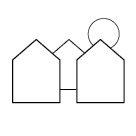The principle of personality encompasses the emotional factors associated with the notion of home, such as the ability to personalize your space through design and your physical belongings. In our second in-office survey, we asked the VDTA staff to identify 3 factors that they aspired to have in their homes. 50% ranked personality as one of these 3 factors, making it the highest response.
Aspire to Have in a Home
After gaining a further understanding of the importance of personality within a home, we asked the VDTA staff to identify 2 words that described their homes now versus in 5 years. We then carefully analyzed their definitions, grouping similar responses, resulting in a list of 20 descriptors. Among these 20 words, bright (natural daylight), comfy (sense of warmth) and character (design characteristics) were the 3 most commonly used. These 3 descriptors are all contributing factors to the category of personality, which further emphasizes its importance in an urban home.
Words to Describe Your Home Now Vs. in 5 Years
In a renter's market personalization is not always an option, so how do you make your space your home?
During our site visits in Chicago, Madison and Denver, personality was present in various ways. In some buildings, quirky floor plans allowed for residents to have a unique layout and sequence of spaces. Other times, options in material finishes allowed for customization. Several buildings also permitted their residents to make minor changes to their homes, including custom paint options or switching appliances.
Daylighting, similarly seen in our in-office surveys, was a significant factor that we observed on our tours. It seemed that residents gravitated towards spaces with natural light and were more inclined to spend their time there. Many buildings that included conference rooms did not have access to natural light and we rarely saw residents using these spaces. Instead, many utilized the shared social spaces to work from home, where there was an abundance of natural light.
Abundant natural light promotes community and safety. People gather in spaces with lots of natural light, and they feel safer in places that are well lit. Daylighting also provides a curated experience that connects people to natural circadian rhythms. Access to natural light provides cues on when it’s time for work and play, and when it is time for relaxation and sleep. So, community spaces that include daylight and the feeling of progression from morning to night will continue to be popular amenities. [11]
How will personality play a role in future urban homes?
Flexibility, categorized as the ability to customize a space or having short-term rental options, will play a vital role in people’s preferences and needs in an urban home. With an increase in telecommuting and the amount of companies offering work from home options, the home no longer needs to be permanent. Projects such as Nest Tool Kit, Flat 27A, MVRDV’s (W)Ego House, and Common Co-living have reacted to the trend of flexibility.
Younger buyers tend to gravitate toward smaller, open-concept spaces that can be tailored to their preferences, as opposed to those with dedicated kitchen, dining and living spaces that cannot be customized. [12]
‘Dynamic personalization’ is one of the primary qualities we’re likely to see in the near future of urban housing. While apartments will likely continue to trend toward ‘micro’ sizes, making room for the many millions of people moving to cities each year, they also need to meet the changing needs of increasingly mobile occupants. Modular and transforming components inside these small apartments, like Murphy beds, fold-down tables, multi-use furniture and custom kitchen modules as well as interior fittings that make use of the full height of the space will likely become the norm. [7]












